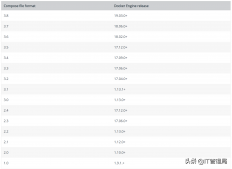什么是微型前端方法?微前端術(shù)語首先在2016年11月的思想技術(shù)雷達(dá)中提出來。它將微服務(wù)的概念擴(kuò)展到前端開發(fā)。
該方法是通過分解應(yīng)用功能來將基于瀏覽器的代碼拆分為微前端。通過制作較小且特征為中心的CodeBases,我們實(shí)現(xiàn)了解耦的軟件開發(fā)目標(biāo)。
雖然Codebases已經(jīng)解耦,但用戶體驗(yàn)是連貫的。此外,每個(gè)代碼庫都可以獨(dú)立實(shí)現(xiàn),升級(jí),更新和部署。
這是微前端的天堂。無論框架和版本如何,javascript應(yīng)用程序都由容器啟動(dòng)。這些應(yīng)用程序,遺留和新的,無縫地一起工作,并類似于一個(gè)應(yīng)用程序。
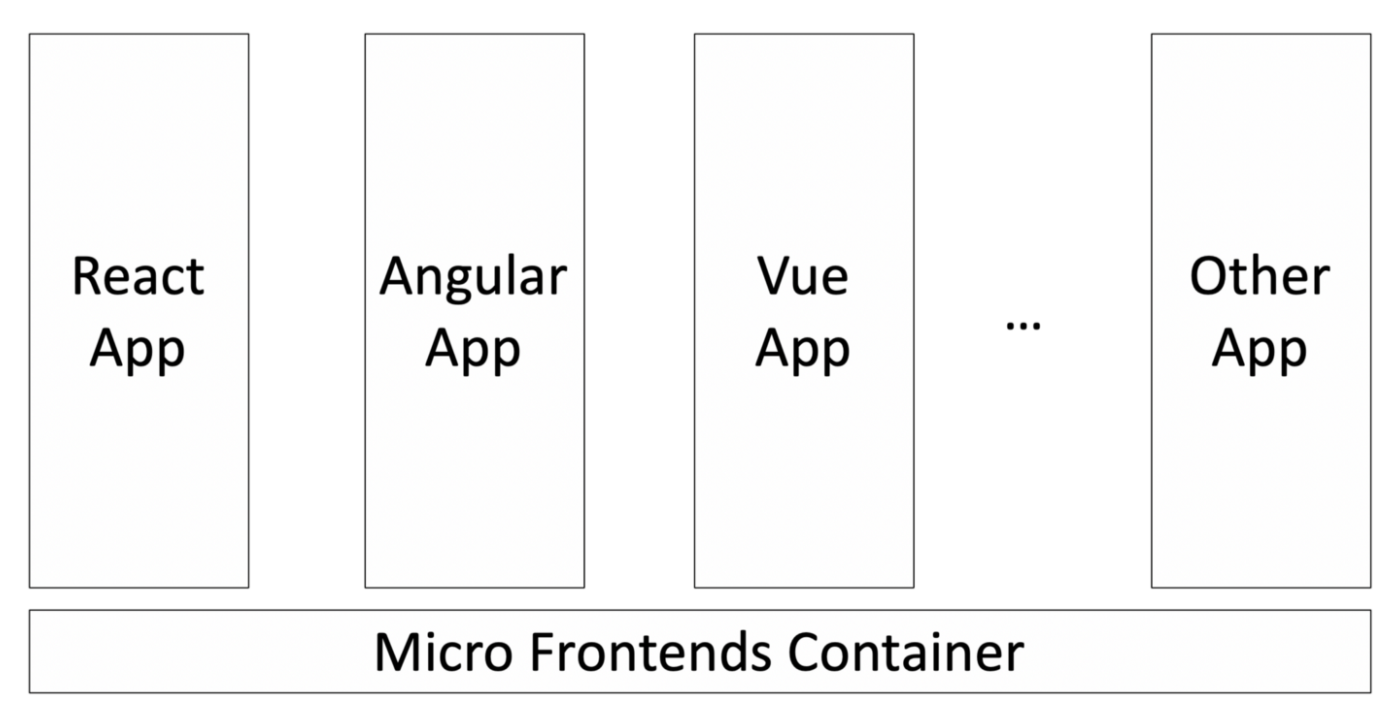
在我們的示例中,我們將解決更簡(jiǎn)單的React微型前端的情況。
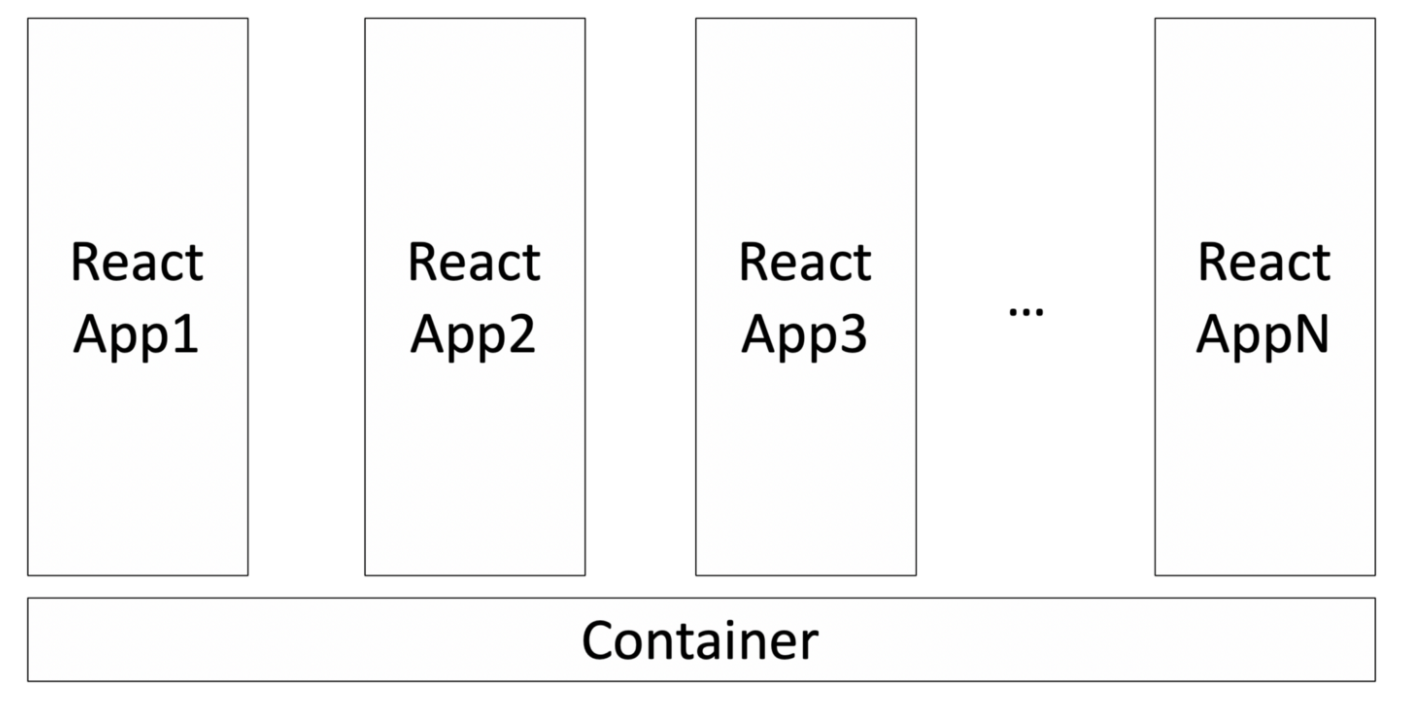
在建立發(fā)起React應(yīng)用程序的微型前端容器的前程工作
此容器需要具有啟動(dòng)隨機(jī)反應(yīng)應(yīng)用程序的能力,而不知道許多細(xì)節(jié)。此外,由于微前端的概念,這層需要很薄,商業(yè)邏輯很少。
幸運(yùn)的是,Cam Jackson公布了他的微觀前端工作,讓我們采用。他的工作在這個(gè)地點(diǎn)可以獲得:
- 容器:微前端演示的入口點(diǎn)和容器應(yīng)用。
- 用于瀏覽餐館的微型前端:瀏覽。
- 從餐廳訂購食物的微型前端:餐廳訂購。
- 內(nèi)容服務(wù)器:將靜態(tài)內(nèi)容存儲(chǔ)微前端演示的位置。
這是微型前端工作的工作流程:
- 啟動(dòng)內(nèi)容服務(wù)器。
- 在特定端口啟動(dòng)瀏覽和餐廳訂購應(yīng)用程序。
- 基于URL,容器將路線到其中一個(gè)微型前端。
- 所選的Micro前端轉(zhuǎn)到特定端口以獲取應(yīng)用程序的資產(chǎn)清單.JSON。從此JSON文件中,包含的main.js置于腳本標(biāo)記并加載。
清單文件包含對(duì)其相應(yīng)的輸出文件的所有資產(chǎn)文件名的映射,以便在不必解析index.html的情況下可以選擇它。該容器的核心是以下Microfrontend.js:
- import React from 'react';
- class MicroFrontend extends React.Component {
- componentDidMount() {
- const { name, host, document } = this.props;
- const scriptId = `micro-frontend-script-${name}`;
- if (document.getElementById(scriptId)) {
- this.renderMicroFrontend();
- return;
- }
- fetch(`${host}/asset-manifest.json`)
- .then(res => res.json())
- .then(manifest => {
- const script = document.createElement('script');
- script.id = scriptId;
- script.crossOrigin = '';
- script.src = `${host}${manifest['main.js']}`;
- script.onload = this.renderMicroFrontend;
- document.head.appendChild(script);
- });
- }
- componentWillUnmount() {
- const { name, window } = this.props;
- window[`unmount${name}`](`${name}-container`);
- }
- renderMicroFrontend = () => {
- const { name, window, history } = this.props;
- window[`render${name}`](`${name}-container`, history);
- };
- render() {
- return <main id={`${this.props.name}-container`} />;
- }
- }
- MicroFrontend.defaultProps = {
- document,
- window,
- };
- export default MicroFrontend;
第13到22行包含要啟動(dòng)微型前端的代碼。通常,微前端之間沒有通信,并且容器與微前端之間的通信有限。
通常,它是從容器到微前端的一種方式。在這里,第34行通過ContainerID和歷史,因?yàn)樗奈⑶岸舜尸F(xiàn)如下:
- ReactDOM.render(<App history={history} />,
- document.getElementById(containerId));
第18行將腳本的Crondorigin值設(shè)置為空,這相當(dāng)于匿名。這意味著元素的請(qǐng)求將使其模式設(shè)置為CORS及其憑據(jù)模式設(shè)置為相同原點(diǎn)。
我們?cè)趯?shí)際代碼中修改了Came的示例。無論如何,這是我們使用的基礎(chǔ)。基于此,我們可以向您展示如何將應(yīng)用程序轉(zhuǎn)換為微前端。
5個(gè)步驟將隨機(jī)反應(yīng)應(yīng)用程序轉(zhuǎn)換為微前端
我們?yōu)殡S機(jī)反應(yīng)應(yīng)用程序的選擇是創(chuàng)建React應(yīng)用程序。將其變成微前端需要五個(gè)步驟。
關(guān)于Facebook的皇冠珠寶應(yīng)用程序的許多原則都在創(chuàng)建React應(yīng)用程序的10個(gè)有趣的事實(shí)中描述。在本文中,我們強(qiáng)調(diào)應(yīng)用這些原則。
第1步:修改package.json以設(shè)置端口并使用“React-App-Rewifire”
- {
- "name": "my-app",
- "version": "0.1.0",
- "private": true,
- "dependencies": {
- "@testing-library/jest-dom": "^4.2.4",
- "@testing-library/react": "^9.4.0",
- "@testing-library/user-event": "^7.2.1",
- "react": "^16.12.0",
- "react-dom": "^16.12.0",
- "react-scripts": "3.4.0",
- "react-app-rewired": "2.1.5"
- },
- "scripts": {
- "start": "PORT=4000 react-app-rewired start",
- "build": "react-app-rewired build",
- "test": "react-app-rewired test",
- "eject": "react-scripts eject"
- },
- "eslintConfig": {
- "extends": "react-app"
- },
- "browserslist": {
- "production": [
- ">0.2%",
- "not dead",
- "not op_mini all"
- ],
- "development": [
- "last 1 chrome version",
- "last 1 firefox version",
- "last 1 safari version"
- ]
- }
- }
- 在第12行中,添加react-app-rewired作為依賴項(xiàng),這允許在不彈出它的情況下自定義應(yīng)用程序。
- 在第15行中,應(yīng)用程序的啟動(dòng)端口已從默認(rèn)端口3000更改為所選的4000 - 這避免了由于容器本身在端口3000上運(yùn)行以來端口沖突。
- 從15號(hào)線到第17行,反應(yīng)腳本由Reft-App-Rewifired替換。
使用新端口,創(chuàng)建React應(yīng)用程序顯示UI如下所示。(我們欺騙了一點(diǎn)。使用React-App-Rewired需要在應(yīng)用程序運(yùn)行之前更改步驟2。)
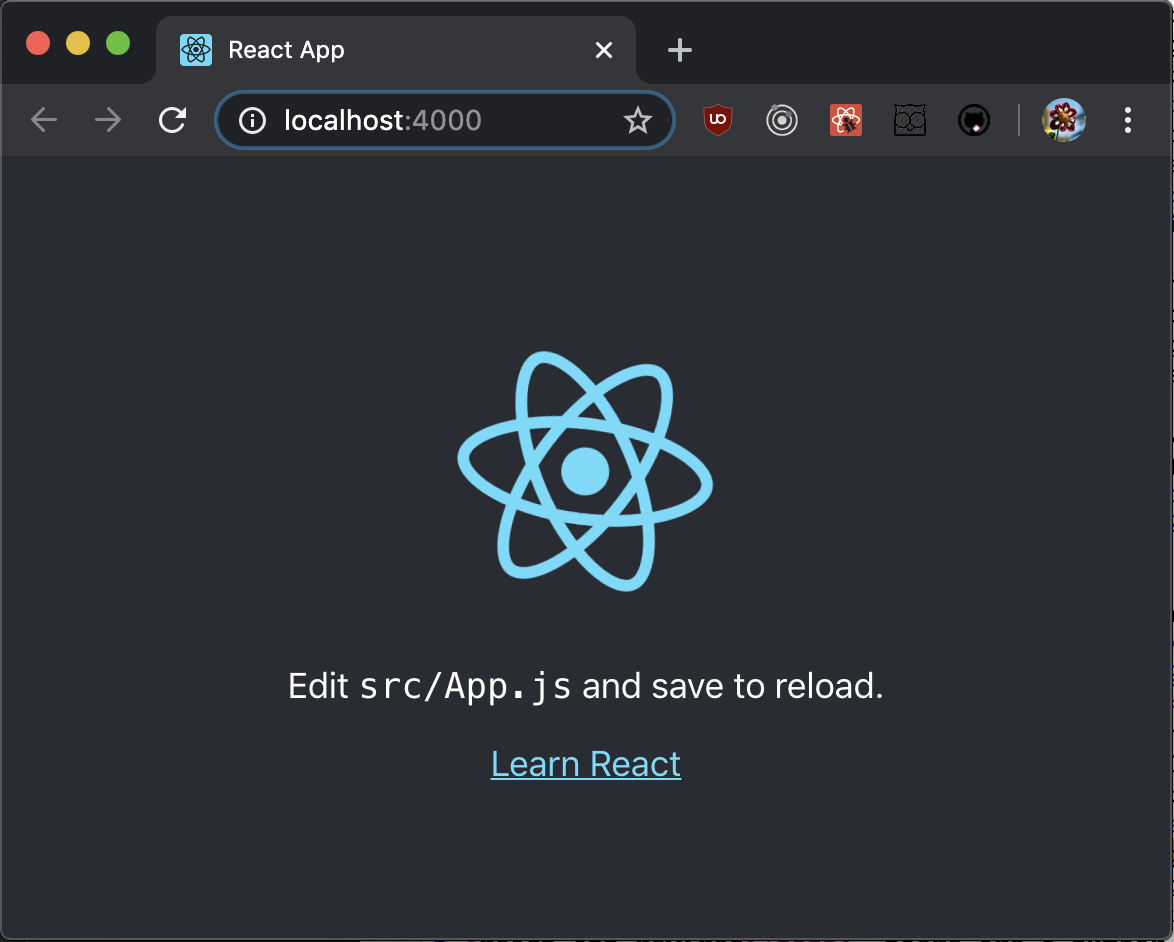
步驟2:使用config-overrides.js禁用代碼拆分
默認(rèn)情況下,啟用代碼拆分。應(yīng)用程序分為多個(gè)可以獨(dú)立加載到頁面上的塊。
http:// localhost:4000 / asset-manifest.json 顯然顯示該應(yīng)用程序已被捆綁。
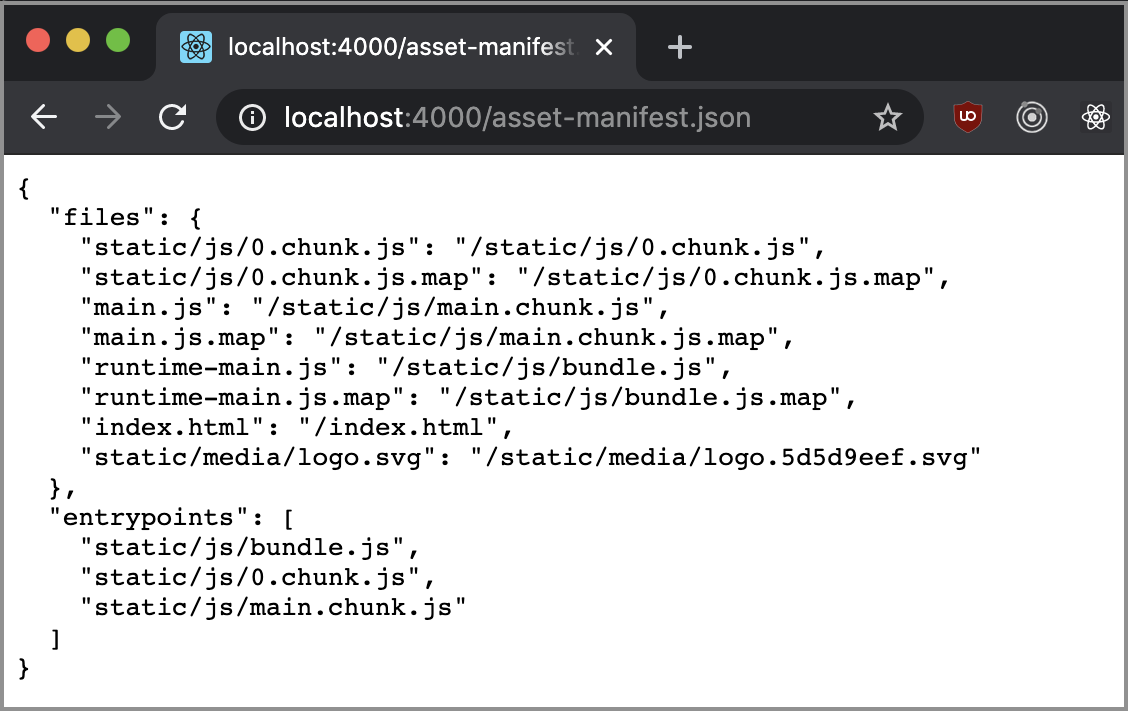
此加載優(yōu)化會(huì)導(dǎo)致掛載和卸載Micro Front-Ender的問題。我們需要通過創(chuàng)建或編輯config-overrides.js來禁用塊,如下所示:
- module.exports = {
- webpack: (config, env) => {
- config.optimization.runtimeChunk = false;
- config.optimization.splitChunks = {
- cacheGroups: {
- default: false,
- },
- };
- return config;
- },
- };
之后,http:// localhost:4000 / asset-manifest.json顯示沒有塊。
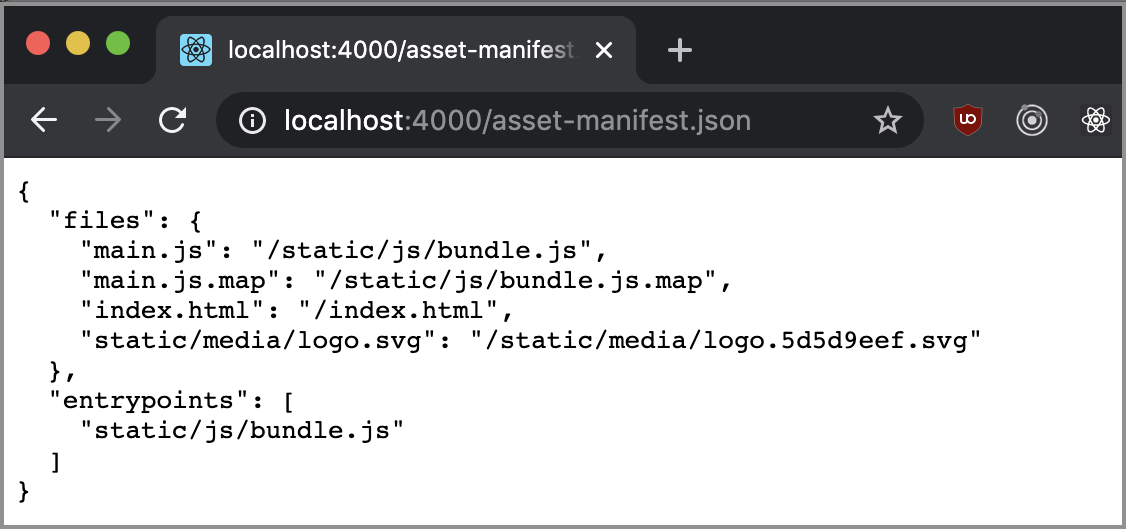
如果未從Create React應(yīng)用程序生成React應(yīng)用程序,則可以通過修改WebPack配置來完成步驟1和步驟2。
如果使用我們的改進(jìn)的MicroFrontend.js,則不必在步驟1中使用React-App-Rewifirew,并且可以完全跳過步驟2。5步減少到3.5。詳細(xì)信息描述于“您不必對(duì)微前端丟失優(yōu)化”中。
此保存在此回購的ChunkOptimization分支中捕獲。
第3步:在SRC / index.js中進(jìn)行更改以定義渲染和卸載功能
讓我們來看看瀏覽Micro前端的SRC / index.js:
- import 'react-app-polyfill/ie11';
- import React from 'react';
- import ReactDOM from 'react-dom';
- import App from './App';
- import { unregister } from './registerServiceWorker';
- window.renderBrowse = (containerId, history) => {
- ReactDOM.render(
- <App history={history} />,
- document.getElementById(containerId),
- );
- unregister();
- };
- window.unmountBrowse = containerId => {
- ReactDOM.unmountComponentAtNode(document.getElementById(containerId));
- };
window.RenderBrowse和window.unmountBrowse定義。這些方法由容器的Microfrontend.js調(diào)用。需要為Create React應(yīng)用程序的SRC / index.js 定義類似的方法。
- import React from 'react';
- import ReactDOM from 'react-dom';
- import './index.css';
- import App from './App';
- import * as serviceWorker from './serviceWorker';
- // render micro frontend function
- window.renderCreatereactapp = (containerId, history) => {
- ReactDOM.render(
- <App history={history}/>,
- document.getElementById(containerId)
- );
- serviceWorker.unregister();
- };
- // unmount micro frontend function
- window.unmountCreatereactapp = containerId => {
- ReactDOM.unmountComponentAtNode(document.getElementById(containerId));
- };
- // Mount to root if it is not a micro frontend
- if (!document.getElementById('Createreactapp-container')) {
- ReactDOM.render(<App />, document.getElementById('root'));
- }
- // If you want your app to work offline and load faster, you can change
- // unregister() to register() below. Note this comes with some pitfalls.
- // Learn more about service workers: https://bit.ly/CRA-PWA
- serviceWorker.unregister();
從第7行到第19行,窗口.RenderCreateActApp和Window.unmountCreaterActApp正在添加。
第23線變?yōu)闂l件。如果它是一個(gè)獨(dú)立的應(yīng)用程序,它將被呈現(xiàn)為根元素。如果它是一個(gè)微型前端,它將通過window.rendercreateActapp呈現(xiàn)給ContainID。
第4步:使用src / setupproxy.js設(shè)置CORS規(guī)則
在Web瀏覽器中啟動(dòng)Micro前端時(shí),我們獲得了CORS錯(cuò)誤:
- Access to fetch at ‘http://localhost:4000/asset-manifest.json' from origin ‘http://localhost:3000' has been blocked by CORS policy: No ‘Access-Control-Allow-Origin’ header is present on the requested resource. If an opaque response serves your needs, set the request’s mode to ‘no-cors’ to fetch the resource with CORS disabled.
必須通過創(chuàng)建或編輯src / setupproxy.js來設(shè)置以下代理。
- module.exports = app => {
- app.use((req, res, next) => {
- res.header('Access-Control-Allow-Origin', '*');
- next();
- });
- };
在進(jìn)行第5步之前,我們?yōu)槿萜髯隽艘恍╊~外的工作。
在.env文件中,需要添加新的Host
React_App_CreateActApp_Host。端口4000需要匹配創(chuàng)建React App正在運(yùn)行的Real Port。
- REACT_APP_BROWSE_HOST=http://localhost:3001
- REACT_APP_RESTAURANT_HOST=http://localhost:3002
- REACT_APP_CREATEREACTAPP_HOST=http://localhost:4000
- REACT_APP_CONTENT_HOST=http://localhost:5000
需要對(duì).env.生產(chǎn)需要做類似的變化:
- REACT_APP_BROWSE_HOST=https://browse.demo.microfrontends.com
- REACT_APP_RESTAURANT_HOST=https://order.demo.microfrontends.com
- REACT_APP_CREATEREACTAPP_HOST=https://createreactapp.demo.microfrontends.com
- REACT_APP_CONTENT_HOST=https://content.demo.microfrontends.com
在App Header.is中添加導(dǎo)航鏈接,以使UI可訪問。這是可選的。
- import React from 'react';
- import { NavLink } from 'react-router-dom';
- import './AppHeader.css';
- const AppHeader = () => (
- <header>
- <div className="center-column">
- <h1> Feed me</h1>
- </div>
- <nav>
- <ol className="center-column">
- <li>
- <NavLink to="/">Browse restaurants</NavLink>
- </li>
- <li>
- <NavLink to="/random">Surprise me</NavLink>
- </li>
- <li>
- <NavLink to="/createreactapp">Create React App</NavLink>
- </li>
- <li>
- <NavLink to="/about">About</NavLink>
- </li>
- </ol>
- </nav>
- </header>
- );
- export default AppHeader;
將CreateAteActApp及其路由添加到Container的App.js中:
- import React from 'react';
- import { BrowserRouter, Switch, Route, Redirect } from 'react-router-dom';
- import AppHeader from './AppHeader';
- import MicroFrontend from './MicroFrontend';
- import About from './About';
- const {
- REACT_APP_BROWSE_HOST: browseHost,
- REACT_APP_RESTAURANT_HOST: restaurantHost,
- REACT_APP_CREATEREACTAPP_HOST: createreactappHost,
- } = process.env;
- let numRestaurants = 0;
- fetch(`${process.env.REACT_APP_CONTENT_HOST}/restaurants.json`)
- .then(res => res.json())
- .then(restaurants => {
- numRestaurants = restaurants.length;
- });
- const getRandomRestaurantId = () =>
- Math.floor(Math.random() * numRestaurants) + 1;
- const Browse = ({ history }) => (
- <MicroFrontend history={history} host={browseHost} name="Browse" />
- );
- const Restaurant = ({ history }) => (
- <MicroFrontend history={history} host={restaurantHost} name="Restaurant" />
- );
- const Createreactapp = ({ history }) => (
- <MicroFrontend history={history} host={createreactappHost} name="Createreactapp" />
- );
- const Random = () => <Redirect to={`/restaurant/${getRandomRestaurantId()}`} />;
- const App = () => (
- <BrowserRouter>
- <React.Fragment>
- <AppHeader />
- <Switch>
- <Route exact path="/" component={Browse} />
- <Route exact path="/restaurant/:id" component={Restaurant} />
- <Route exact path="/createreactapp" component={Createreactapp} />
- <Route exact path="/random" render={Random} />
- <Route exact path="/about" render={About} />
- </Switch>
- </React.Fragment>
- </BrowserRouter>
- );
- export default App;
現(xiàn)在讓我們?cè)囍故疚覀兊奈⑿颓岸恕?/p>
- 內(nèi)容服務(wù)器:NPM啟動(dòng)。
- 瀏覽Micro前端:NPM開始。
- 餐廳訂購微型前端:NPM開始。
- Create React App Micro前端:NPM開始。
- 容器:NPM開始。
轉(zhuǎn)到localhost:3000 / createActapp來啟動(dòng)頁面。

哎呀,React spinning 日志在哪里?
讓我們重新審視http:// localhost:4000 / asset-manifest.json。Micro前端的徽標(biāo)是一個(gè)單獨(dú)的文件:
- {
- "files": {
- "main.js": "/static/js/bundle.js",
- "main.js.map": "/static/js/bundle.js.map",
- "index.html": "/index.html",
- "static/media/logo.svg": "/static/media/logo.5d5d9eef.svg"
- },
- "entrypoints": [
- "static/js/bundle.js"
- ]
- }
我們忘了抓住它!

查看此徽標(biāo)SVG文件的來源,該文件被設(shè)置為/static/media/logo.5d5d9eef.svg。此文件可在Create React App(HTTPS:// localhost:4000)中使用,但不在容器中(http:// localhost:3000)。

這是我們的最后一步。
步驟5:在.env文件中配置內(nèi)容主機(jī)并將其用來前綴靜態(tài)內(nèi)容
創(chuàng)建或編輯.env以設(shè)置內(nèi)容主機(jī):
- REACT_APP_CONTENT_HOST=http://localhost:4000
當(dāng)Micro前端使用靜態(tài)內(nèi)容時(shí),它需要在HTML中的%React_App_Content_host%前綴,并在JavaScript中的
Process.env.reacect_app_content_host。
在這里,我們?cè)趕rc / app.js中更改了第9行:
- import React from 'react';
- import logo from './logo.svg';
- import './App.css';
- function App() {
- return (
- <div className="App">
- <header className="App-header">
- <img src={`${process.env.REACT_APP_CONTENT_HOST}${logo}`} className="App-logo" alt="logo" />
- <p>
- Edit <code>src/App.js</code> and save to reload.
- </p>
- <a
- className="App-link"
- href="https://reactjs.org"
- target="_blank"
- rel="noopener noreferrer"
- >
- Learn React
- </a>
- </header>
- </div>
- );
- }
- export default App;
使用此更改,徽標(biāo)SVG文件以http:// localhost:4000前綴。

該應(yīng)用程序現(xiàn)在正常工作。
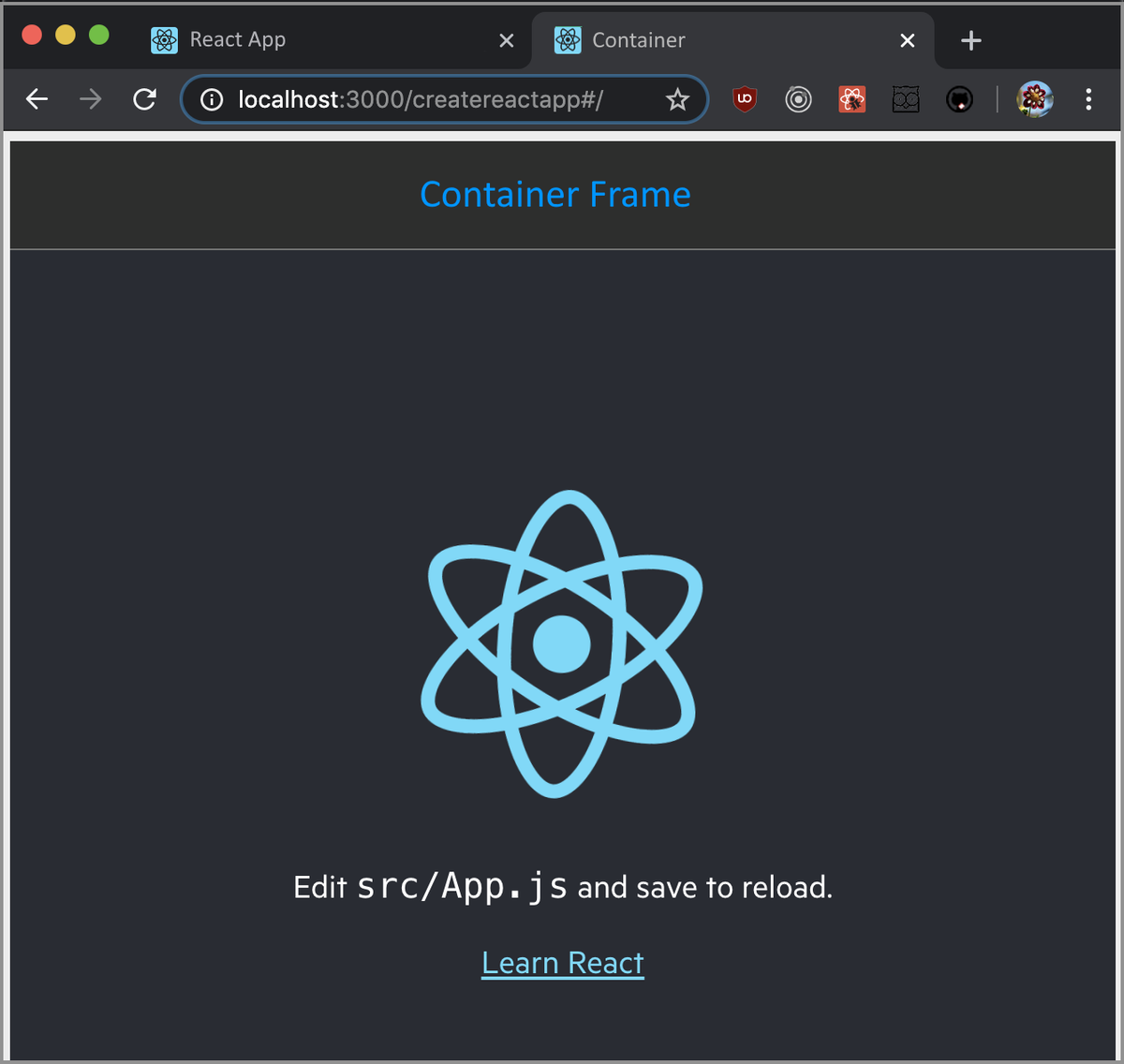
原文鏈接:https://betterprogramming.pub/5-steps-to-turn-a-random-react-application-into-a-micro-frontend-946718c147e7






